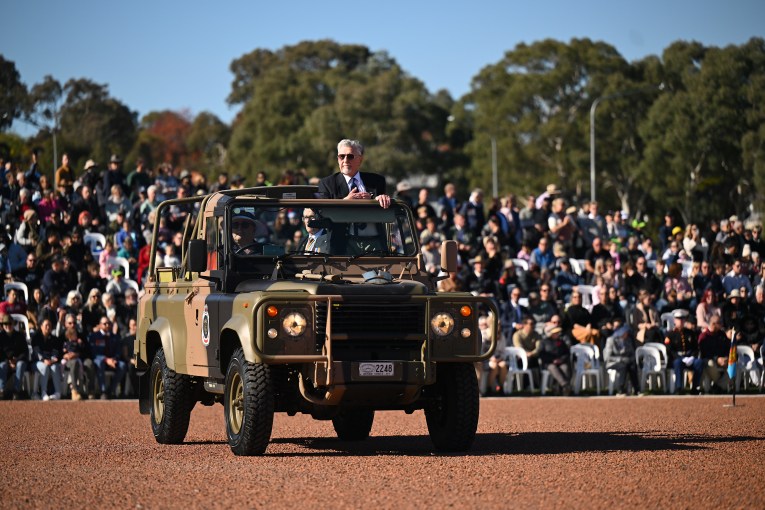Twiggy’s plan to drought-proof Australia
Iron ore billionaire Andrew ‘Twiggy’ Forrest has a dream, and like most things he’s tackled in his business life, it is big.
Mr Forrest wants to drought proof Australia.
• Hockey’s climate black out
• Prepare to work longer: IGR
• Intergenerational Report a farcical proposition
“Everything I know starts with a dream, and the dream I want to share with you is an Australia which does not fear lack of water,” he told a conference in Canberra this week.
Mr Forrest’s plan is to harvest 5,000 gigalitres of water from underground aquifers and rivers to drought proof existing agricultural areas, and open up thousands of hectares of land for new agricultural projects.
“It will make our entire nation stronger,” he said, as he announced his grand waterproofing plan at the annual ABARES (Australian Bureau of Agricultural and Resource Economics and Sciences) Outlook conference in Canberra.
Mr Forrest said the plan stemmed from his childhood growing up on a station in the Pilbara.
“I grew up in the bush and the pastoral station in the Pilbara in the far north-west isolated outback,” he said.
“I saw the agony and I felt the pain it caused my parents, such anguish as they bore personal witness to the ravaging effects of drought while the vegetation around us wilted.
“It was not until I saw the wildlife, the birds, the kangaroos, emus, goannas and eventually the sheep and cattle all meet – by their thousands – their dry and dusty and painful death. It’s those emotions that I can never forget.”
Project calls for support of Chinese and Australian governments
Mr Forrest expects his plan will attract sceptics and critics, but maintains with support from the Australian and Chinese governments, financial backing from Chinese investors, and advice from Australia’s top water scientists, it can be done.
“Development of such a massive and underutilised resource will take serious investment,” he said.
“I can assemble the people with that same innovative spirit and project leadership that helped me build Fortescue from scratch to the great company it is today.”
He anticipated much of the funding would come from Chinese investors.
“They are capable of being long, strong and passive partners on massive scale which our capital alone could not develop,” Mr Forrest said.
He said the Chinese would not be intimidated by the amount of capital required or the long-term nature of the payback.
Mick Keogh, executive director of the Australian Farm Institute, said it was unlikely the money needed could be found in Australia.
“If we look at the examples of Cubbie and Ord stage two, I am not sure there is the investment appetite in the Australian financial sector to take on the risks and time frames associated with getting those operational and making them profitable,” he said.
“I don’t think we have much choice that the patient capital is going to come from overseas for those sorts of projects, so I think he is right in engaging the Chinese demand.”
‘Infrastructure key to unlocking potential of Australian agriculture’
Mr Forrest said it was time to spend big on infrastructure, as recent free trade agreements with Asian countries would bring enormous opportunities for Australian farmers.
“Infrastructure is the great key to unlocking the potential of Australian agriculture,” he said.
“It is what builds nations.”
Mr Forrest nominated the Canning Basin in Western Australia as a good place to start.
“If we locate many of our water intensive industries to the Canning Basin where there is yet none we’d barely dent its huge water carrying capacity,” he said.
“Each year its recharges is literally topped up again like a bath tub. Take it out at one end, its topped up again the other.”
Mr Forrest said Australia’s agricultural sector reminded him of the self-evident opportunity he saw when he started Fortescue in the early 2000s.
“I had a vision for the iron ore industry and now it’s one of the world’s largest iron ore complexes exporting $15 to 20 billion worth of iron ore a year,” he said.
Mr Forrest said he would have a scoping study done by the end of the year.
Ambitious plan welcomed by Truss, National Farmers’ Federation
At the conference, his plan, while light on detail, was welcomed as the sort of bold transformational thinking required if Australian farmers were to capitalise on the opportunities opening up in Asia.
“Sounds good to me, we just have to find a practical way of doing it,” Federal Infrastructure Minister Warren Truss said.
“Everyone likes to quote the statistic that 60 per cent of the nation’s rain falls in the north and very little is used for agriculture, so clearly there is enormous potential to harvest the northern rivers.”
So many explorers met their own deaths yet [water] was not in front of them but beneath their feet.
Andrew ‘Twiggy’ Forrest
National Farmers’ Federation chief executive Simon Talbot was also full of praise for Mr Forrest’s vision.
“Twiggy is great, the one thing we need in agriculture is leadership. We want to see Twiggy invest and other entrepreneurs invest as well,” Mr Talbot said.
Mr Forrest’s great-great uncle John Forrest was an explorer.
As his great-great nephew pitched his grand water plan he invoked the spirit of the early pioneers, who had no idea of the extraordinary water resource underneath them.
“So many explorers met their own deaths yet it was not in front of them but beneath their feet,” Mr Forrest said.
It is that life saving underground water he plans to harvest and put to work.








